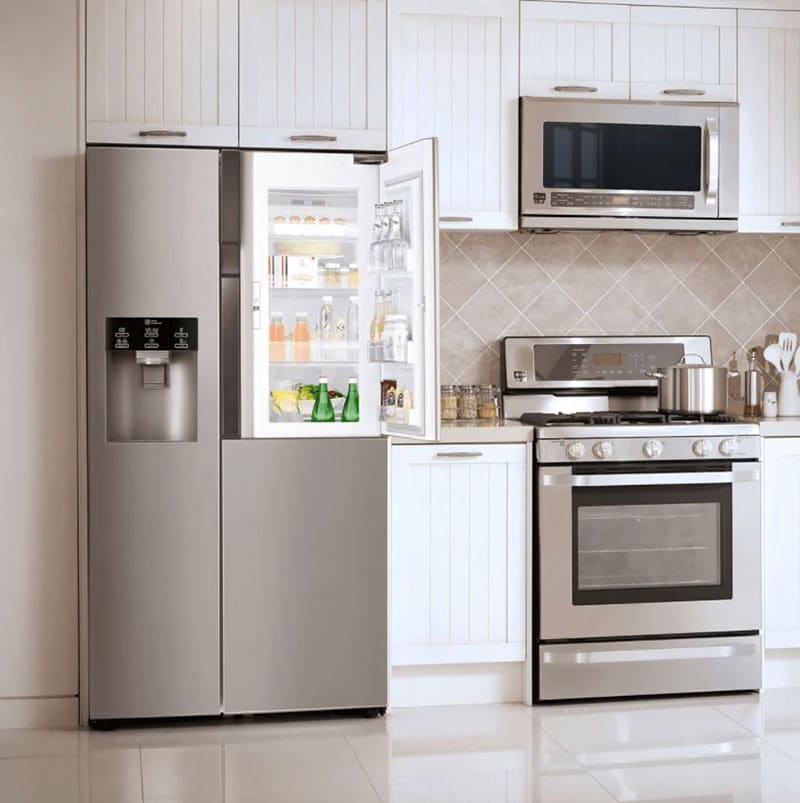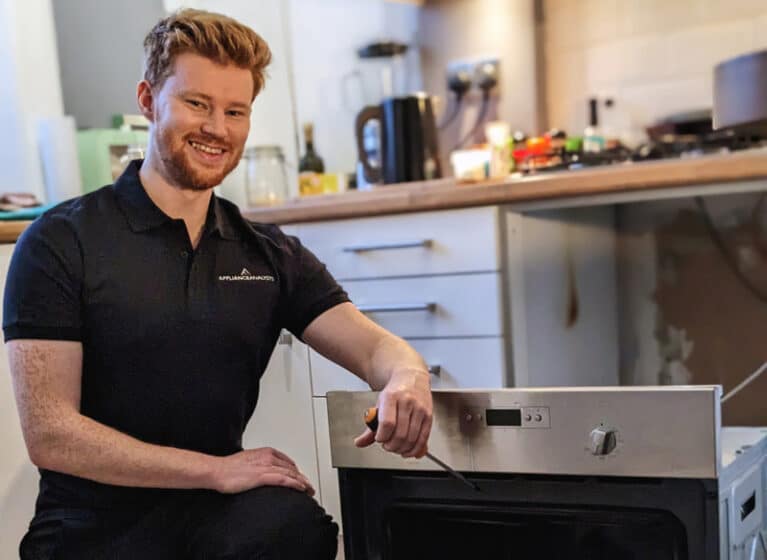Have you run out of slots on your circuit panel? Are you tempted to put the microwave and fridge on the same circuit? This article will explain whether making the two appliances share the same circuit is a dangerous move.
A microwave and fridge can be on the same circuit if:
- The microwave uses less than 10 amps
- Your local electrical code permits you to do so
- Your refrigerator’s manual doesn’t prohibit circuit installation with other appliances
- You live in an old home that has not had its wiring system updated
You should check your local electrical codes before making any kitchen changes. But as I am sure you would agree, just because something is lawful doesn’t mean it’s always the best idea. So, should you put your microwave and fridge on the same circuit?
Take a look at the extended guide below to find out.

Can a Microwave and Fridge Be on One Circuit? It Depends!
Are you remodeling your kitchen? Then you’ve undoubtedly experienced the frustration of not having enough circuits to shuffle your appliances around.
So then, what do you do?
You may be tempted to put the garbage disposal on the same circuit as the dishwasher. You might think of pairing the electric oven with the coffee maker. Or how about the washing machine and the hood?
After all, what’s the worst that could happen?
I’ll leave the answer to the question above to your imagination. But here are some of the dangers of sharing circuits with big electrical appliances:
- You could trip your circuit breaker.
- You could blow your circuit breaker.
- Your electrical wiring could heat up, melt, and start a fire.
So, you’re undoubtedly wondering, should a microwave and a fridge be on one circuit? Take a look below to find out.
Your Microwave’s Electrical Consumption
How can you know whether it’s safe for your microwave and fridge to be on the same circuit? Well, it depends on a few factors.
The first factor is the electrical consumption of your microwave. Do you have a family-sized microwave that can heat your meal in 30 seconds flat? Then the chances are it’s a big energy hog. I tend to find that the safest option with powerful microwaves is to put them on their own circuit.
If your microwave is smaller, you may be able to put it on a shared circuit, but it greatly depends on its electrical consumption along with other factors.
If your microwave uses 10 amps or less, it could be safe to connect with other electrical appliances. However, you still need to keep your area’s electrical code in mind and double-check your microwave and fridge’s User Manual.
A cheap and lightweight countertop microwave will draw anywhere between 700–800 watts, whereas an over-the-range variant can draw up to 1,000-1,200.
Before making any kitchen changes, you should check your local electrical codes. Why is it so important that you do so? Here are two reasons:
- Your local electrical code may differ from your appliance’s user manual. Your manual may say that your appliance can share a circuit with another. But your local electrical code may prohibit you from doing so.
- Your local electrical code may have different rules for older and new houses. Older houses typically run on far fewer circuits than more recent houses. Generally, older wiring can stay in place when you remodel the kitchen. These rules give you a lot more freedom of choice for the layout of your electrical appliances.
What should you do if your user manual and your local electrical code have conflicting rules? Then you should follow the guidelines in your local electrical code above all else.
Why? Because your local electrical code is carefully tied in with your home insurance. So, if you don’t follow the rules of your electrical code, you could invalidate your insurance. If something happens in your home and you want to make a claim, you could find yourself in a tricky situation.
Your Microwave and Fridge Manuals

Are you wondering whether putting your microwave and fridge on the same circuit is safe? My usual advice is to check your User Manuals. Here’s why:
- Every kitchen appliance is different. Local laws and internet guides can give you an idea of what’s safe. But there are so many different appliances out there. It would be impossible to make a list of what you can and can’t do for each one. The user’s guide will state whether using your appliance in a joint circuit is safe.
- You must know how many amps are in your circuit. Your user guide will be able to tell you how many amps your appliance uses. Once you know your microwave and fridge’s exact amp information, you can check the maximum amp allowance for your circuit. If two appliances exceed the circuit’s amp allowance, putting them on separate circuits would be best.
Looking at the user manual is important, but your final decision should always be in harmony with your local electrical code.
You Live in an Old Home
The age of your home will also have an impact on whether you can share a circuit with your microwave and fridge. But what are some of the differences between modern and old houses and their kitchens? Take a look below.
| Modern Houses | Older Houses |
|
|
In my experience, older houses come with few electrical circuits. So, large electrical items often end up sharing a circuit.
If you live in an older home, you may have no choice but to put more than one large electrical item on a shared circuit. In most cases, you can share circuits without invalidating your insurance. You will also no doubt have an exemption from your local electrical code. However, I often tell homeowners to double-check their insurance and electrical code before doing any remodeling.
Why Can a Microwave and Fridge Combo Be Risky?
Many kitchen appliances are electricity hogs. Here is a list of the biggest electricity drainers in your home:
- Microwave
- Refrigerator and freezer combo
- Electric oven
- Range Hood
- Dishwasher
- Coffee maker
As you can see from the list, microwaves, and fridges are both massive electricity consumers. And having two big consumers on one electrical circuit can be a bit of a gamble.
You may be wondering – if it’s so risky, why do so many people do it?
The answer is that, although microwaves draw a lot of power when used, it only happens a few minutes daily. So, the time that your microwave is dependent on your electrical circuit is small.
However, the problem isn’t with how much time you use your microwave daily. The problem lies with the combination of microwave use with your fridge cycle. You see, your fridge also has times throughout the day when it is just ticking over, not using much energy. But when it goes through a cooling cycle, and the motors begin to whirl, it starts to consume a lot of energy.
So, if your fridge just so happens to be on cycle at the same time that you’re defrosting a massive turkey in the microwave, you could have a problem.
On average, a fridge needs anywhere between 3–6 amps and a microwave somewhere around 5-8, which can be too much for older houses’ electrical grids.
Conclusion
Deciding whether your microwave and fridge should be on one circuit is tricky. There are so many factors to consider, such as the age of your home and the rules in your local electrical code. You also need to check your appliance’s power use, amp requirement, and your user guide.
If this article has helped you and answered your most burning questions, then why not check out some of our other resources and free guides? You could even sign up for our email list!
Have a great day!
-Craig.








